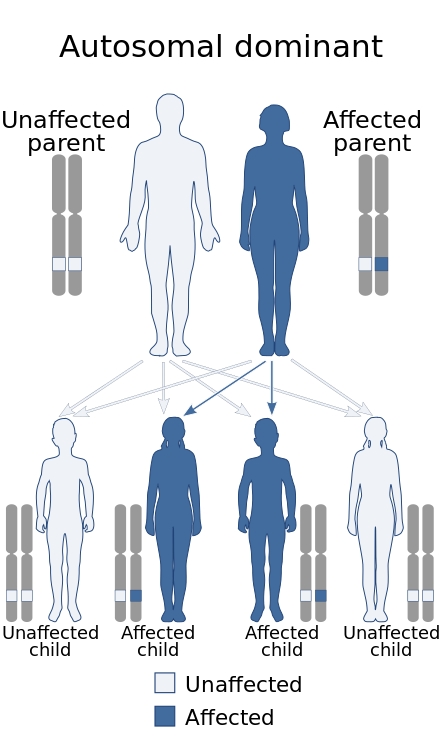Neurofibromatosis
Neurofibromatosis (NF) refers to a group of three distinct genetic conditions characterised by the growth of non-cancerous (benign) tumours in the nervous system. These conditions often involve the skin or surrounding bone and present with varying symptoms. The three types of NF are Neurofibromatosis type 1 (NF1), Neurofibromatosis type 2 (NF2), and schwannomatosis.

Signs and Symptoms
Neurofibromatosis type 1 (NF1) typically manifests with café-au-lait spots (light-brown flat patches of skin), neurofibromas (small bumps in or under the skin), scoliosis (side-way curvature of the back), and headaches. Additionally, children with NF1 may have mild difficulty in school, with about 60% experiencing learning and behaviour problems. Signs of NF1 include:
- Six or more light brown dermatological spots ("café au lait spots")
- At least two neurofibromas
- At least two growths on the eye's iris (Lisch nodules)
- Abnormal growth of the spine (scoliosis)
- Tumours on the adrenal glands (pheochromocytomas)


Neurofibromatosis type 2 (NF2) may present with early-onset hearing loss, cataracts, tinnitus, difficulty walking or maintaining balance, and muscle atrophy. The most characteristic symptom of NF2 is hearing loss, caused by pressure from tumours on the acoustic nerve, which can also lead to headaches, dizziness, and nausea.
The primary symptom of schwannomatosis is localised pain, resulting from nerve compression by nearby tumours.

Cause
The three types of neurofibromatosis are caused by different genetic mutations:
- NF1 is caused by a mutation on the NF1 gene on chromosome 17.
- NF2 is caused by a mutation on the NF2 tumour suppressor gene on chromosome 22.
- Schwannomatosis is caused by various mutations on chromosome 22.
Neurofibromatosis is inherited in an autosomal dominant pattern, meaning only one copy of the affected gene is necessary for the condition to develop. If one parent has neurofibromatosis, there is a 50% chance their offspring will inherit the condition.

Pathophysiology
Neurofibromatosis type I: Caused by genetic changes in the NF1 gene on chromosome 17, encoding the tumour suppressor protein neurofibromin. Dysfunction or lack of neurofibromin leads to uncontrolled cell proliferation and tumour formation. Neurofibromin also plays a role in cognition, explaining cognitive impairments in NF1 patients.
Neurofibromatosis type II: Caused by a mutation on chromosome 22 affecting the NF2 tumour suppressor gene, which encodes the protein merlin. The loss of merlin function leads to unregulated growth factor activity and tumour formation.
Schwannomatosis: Caused by a mutation on the SMARCB1 gene, leading to loss of function in a tumour suppressor protein complex.
Diagnosis
Diagnosis of neurofibromatosis includes:
- Radiograph
- MRI or CT scan
- EEG
- Slit-lamp examination
- Genetic testing
- Histology
Differential Diagnosis
Conditions similar to NF include:
- LEOPARD syndrome
- Legius syndrome
- Proteus syndrome
- Macrodystrophia lipomatosa
- Klippel–Trénaunay syndrome
- Parkes Weber syndrome
Treatment
Treatment options include surgical removal of tumours, which carries inherent risks. For optic pathway gliomas (OPG), chemotherapy is preferred, while radiotherapy is not recommended for children. Regular examinations are advised for early detection and monitoring of potential growths or changes.
Prognosis
Most cases of NF1 are mild, and individuals can lead normal lives. However, severe cases can cause significant cosmetic and psychological issues. The course of NF2 varies, and damage to essential structures can be life-threatening. Schwannomatosis often causes significant pain, which can be severe and disabling in extreme cases.
Epidemiology
In the United States:
- 1 in 3,500 people have NF1
- 1 in 25,000 have NF2
- 1 in 40,000 have schwannomatosis
Males and females are equally affected. NF1 symptoms are often present at birth or develop before age 10, while NF2 symptoms typically appear in early adulthood. Schwannomatosis symptoms develop in early childhood. Life expectancy is generally normal for those with NF1 and schwannomatosis but may be shortened in NF2.
History
Descriptions of neurofibromatosis date back to the 1st century. The conditions were formally described by Friedrich Daniel von Recklinghausen in 1882.
Self-assessment MCQs (single best answer)
Which type of neurofibromatosis typically manifests with café-au-lait spots and neurofibromas?
What is the primary symptom of schwannomatosis?
What causes Neurofibromatosis type 1 (NF1)?
Which gene mutation is responsible for Neurofibromatosis type 2 (NF2)?
What is the inheritance pattern of neurofibromatosis?
Which diagnostic method is NOT typically used for neurofibromatosis?
What percentage of children with NF1 experience learning and behaviour problems?
Which protein is affected by the mutation in Neurofibromatosis type 2?
Which of the following is a common symptom in Neurofibromatosis type 2 (NF2)?
What is the prevalence of NF1 in the United States?
Dentaljuce
Dentaljuce provides Enhanced Continuing Professional Development (CPD) with GDC-approved Certificates for dental professionals worldwide.
Founded in 2009 by the award-winning Masters team from the School of Dentistry at the University of Birmingham, Dentaljuce has established itself as the leading platform for online CPD.
With over 100 high-quality online courses available for a single annual membership fee, Dentaljuce offers comprehensive e-learning designed for busy dental professionals.
The courses cover a complete range of topics, from clinical skills to patient communication, and are suitable for dentists, nurses, hygienists, therapists, students, and practice managers.
Dentaljuce features Dr. Aiden, a dentally trained AI-powered personal tutor available 24/7 to assist with queries and provide guidance through complex topics, enhancing the learning experience.
Check out our range of courses, or sign up now!


